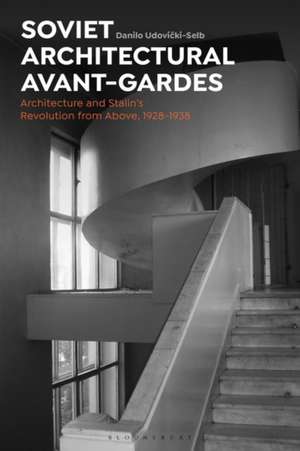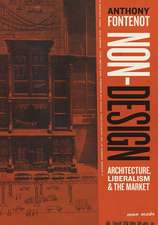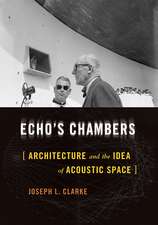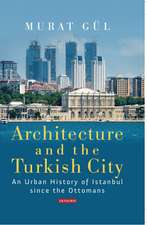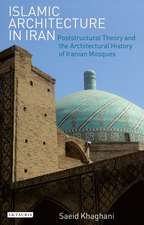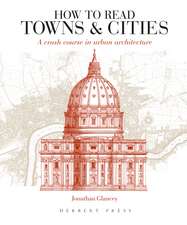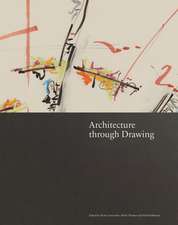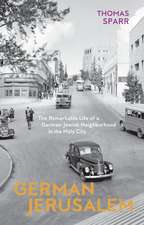Soviet Architectural Avant-Gardes: Architecture and Stalin’s Revolution from Above, 1928-1938
Autor Dr Danilo Udovicki-Selben Limba Engleză Paperback – 12 ian 2022
| Toate formatele și edițiile | Preț | Express |
|---|---|---|
| Paperback (1) | 202.56 lei 3-5 săpt. | +56.16 lei 4-10 zile |
| Bloomsbury Publishing – 12 ian 2022 | 202.56 lei 3-5 săpt. | +56.16 lei 4-10 zile |
| Hardback (1) | 601.63 lei 3-5 săpt. | |
| Bloomsbury Publishing – 27 mai 2020 | 601.63 lei 3-5 săpt. |
Preț: 202.56 lei
Preț vechi: 233.07 lei
-13% Nou
38.77€ • 40.32$ • 32.00£
Carte disponibilă
Livrare economică 25 martie-08 aprilie
Livrare express 08-14 martie pentru 66.15 lei
Specificații
ISBN-10: 135028842X
Pagini: 264
Ilustrații: 72 bw illus
Dimensiuni: 156 x 234 x 20 mm
Greutate: 0.58 kg
Editura: Bloomsbury Publishing
Colecția Bloomsbury Visual Arts
Locul publicării:London, United Kingdom
Caracteristici
Notă biografică
Cuprins
Recenzii
After years of research, Danilo Udovicki-Selb has masterfully mapped one of the major episodes in the history of 20th-century architecture: the backlash against modernism in Stalin's USSR. Considered with subtlety, biographies, discourse and designs are intertwined in a path-breaking, fascinating chronicle.
Danilo Udovicki-Selb's new book makes an important contribution to the history of Soviet architecture. It brings attention to the dramatic story of VOPRA, the All-Union Society of Proletarian Architects, long neglected by historians as a political rather than creative movement. Working in the Russian archives, Udovicki-Selb discovered the real story of the movement, created by Lazar Kaganovich. The book convincingly shows, that once-popular idea "Stalin ordered architects to return to classical architecture," is a gross oversimplification. "The 23 April 1932 Central Committee decree," Udovicki-Selb writes, "did not impose any stylistic direction," and the party even "favored architectural plurality." This is well illustrated by juxtaposing Malevich's Arkhitekton with Boris Iofan's version of the Palace of the Soviets, clearly influenced by Malevich as well as by the Rockefeller Center in New York (which may have been influenced by Malevich as well).
An important contribution to the narrative initiated by Clement Greenberg, Reyner Banham, and Manfredo Tafurri, this book offers a trove of previously unknown documents and discusses a number of projects that until now have escaped the scrutiny of architectural historians. It adds many new nuances to the story of the clash between the revolutionary architecture of the Russian Avant-garde and the Stalinist cultural revolution "from above." This nuanced approach does not make Danilo Udovicki-Selb's account of Kaganovich's intervention that eventually ended the vibrant experiments of the 1920s any less tragic. And yet, his analysis escapes the trap of a melodrama with clear heroes and villains; Udovicki-Selb's most important accomplishment is of highlighting the talent of survivors such as Boris Iofan, Aleksej Dushkin, and the Moisej Ginzburg of the 1930s. Their attempts to preserve the legacy of the avant-garde-even if delivered in a form, acceptable to the soviet dictator-produced several truly remarkable pieces of modernist architecture.
Soviet Architectural Avant-Gardes is an important, engaging book . One of the most original contribution in this specific field of History of architecture and the XX century History of Architecture at large, which marks a significant step forward.Danilo Udovicki-Selb deserves a lot of credit for the essential contribution given to the questioning of what has long been undisputed. The author has succeded in breaking down long-standing historiographical narratives, revealing the complexity and ambiguity of the relationships between the Verkhushka, the Stalinist political power and the multifaceted sphere of professional culture, and how the architectural avant-garde has been in able to persist and develop in in original, sometimes unexpected, and geographically articulated forms, within the unstable and nuanced rhetoric frame of the "Socialist Realism".
Descriere
Conventional readings of the history of Soviet art and architecture show modernist utopian aspirations as all but prohibited by 1932 under Stalin's totalitarianism. Soviet Architectural Avant-Gardes challenges that view. Radically redefining the historiography of the period, it reveals how the relationship between the Party and practicing architects was much more complex and contradictory than previously believed, and shows, in contrast to the conventional scholarly narrative, how the architectural avant-garde was able to persist at a time when it is widely considered to have been driven underground.In doing so, this book provides an essential perspective on how to analyse, evaluate, and "re-imagine" the history of modernist expression in its cultural context. It offers a new understanding of ways in which 20th century social revolutions and their totalitarian sequels inflected the discourse of both modernity and modernism. The book relies on close analyses of archival documents and architectural works. Many of the documents have been rarely - if ever - discussed in English before, while the architectural projects include iconic works such as the Palace of Soviets and the Soviet Pavilion at the Paris 1937 World Exposition, as well as remarkable works that until now have been neglected by architectural historians inside and outside Russia. In a fascinating final chapter, it also reveals for the first time the details of Frank Lloyd Wright's triumphant welcome at the First Congress of Soviet Architects in Moscow in 1937, at the height of Stalin's Terror.
